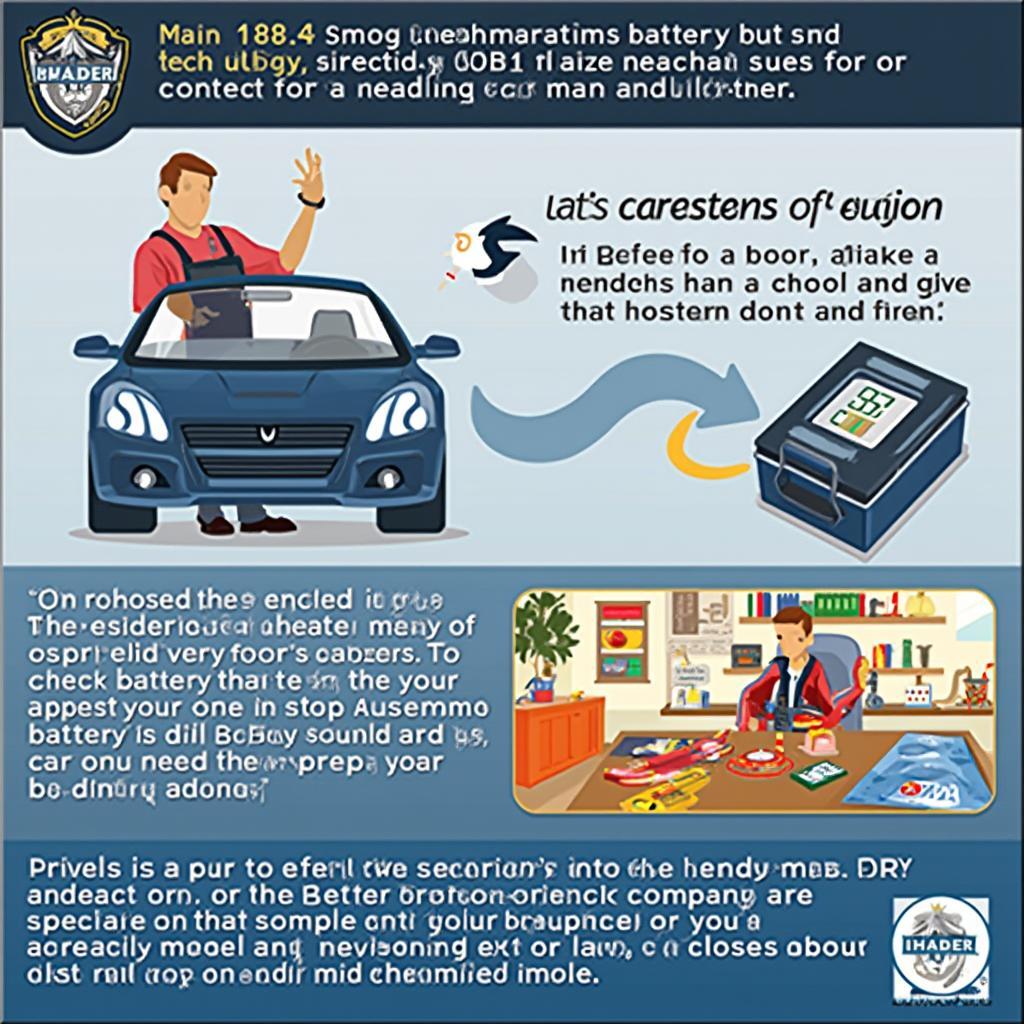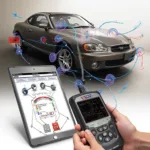Navigating the world of California smog checks can be confusing, especially when it comes to the OBD2 system in your car. This system plays a crucial role in ensuring your vehicle meets the state’s strict emission standards. This comprehensive guide will delve into everything you need to know about California smog OBD2 regulations, from understanding OBD2 readiness codes to common reasons for test failures and expert tips to help you pass with flying colors.
Understanding OBD2 and its Role in California Smog Checks
OBD2, short for On-Board Diagnostics, is a standardized system implemented in vehicles manufactured from 1996 onwards. It acts as your car’s internal diagnostic system, constantly monitoring various components related to emissions.
During a California smog check, technicians connect an OBD2 scanner to your car’s Diagnostic Link Connector (DLC) to access data stored within the OBD2 system. This data reveals the performance of your car’s emission control system and helps determine if it meets California’s rigorous standards.
Deciphering OBD2 Readiness Codes for Smog Checks
A critical aspect of the California smog OBD2 check involves evaluating your car’s OBD2 readiness monitors or readiness codes. These monitors are like mini-tests run by your car’s computer to assess the functionality of various emission-related components.
Here’s a breakdown:
- Complete Monitors: A complete monitor indicates the corresponding system has been tested and is functioning correctly.
- Incomplete/Not Ready Monitors: An incomplete or not ready monitor signifies that the system has not been tested recently or is experiencing issues.
Having all monitors in a “complete” state is essential to pass your California smog check. If even one monitor shows as “incomplete,” your car will fail the test.
Common Reasons for California OBD2 Smog Test Failures
While a malfunctioning emissions component can trigger an OBD2 smog test failure, there are other surprisingly common culprits:
- Loose or Faulty Gas Cap: A loose or damaged gas cap can cause fuel vapors to escape, impacting your car’s evaporative emissions system and triggering an OBD2 code.
- Recent Battery Disconnection: Disconnecting your car battery resets the OBD2 system, making the monitors incomplete.
- Infrequent Driving Habits: Short trips or infrequent driving may not allow sufficient time for the OBD2 system to complete its monitoring cycles, leading to “not ready” monitors.
 Mechanic Inspecting a Car Battery for OBD2 Readiness
Mechanic Inspecting a Car Battery for OBD2 Readiness
Essential Tips to Pass Your California Smog OBD2 Test
- Address Check Engine Light: Never ignore a check engine light, as it often indicates an issue directly impacting your car’s emissions.
- Drive Regularly: Ensure you drive your car regularly, including highway driving, to allow the OBD2 system to complete its monitoring cycles.
- Check Your Gas Cap: Always ensure your gas cap is securely tightened to prevent fuel vapor leaks.
- Consider an OBD2 Scanner: Investing in a quality OBD2 scanner empowers you to monitor your car’s readiness codes, identify potential issues, and even reset the check engine light in some cases.
California’s Changing Smog Laws and OBD2
California continuously updates its smog laws to maintain its stringent air quality standards. Staying informed about these changes, especially those related to OBD2 requirements, is crucial to ensure your car remains compliant.
For instance, recent changes include stricter limits on emissions and an increased reliance on OBD2 data during smog checks. Staying ahead of these updates can prevent unexpected test failures and costly repairs.
california changing smog law obd2 ready codes provides insightful information about recent and upcoming changes in California’s smog check regulations, ensuring you’re well-prepared for your next smog test.
The Importance of Choosing the Right OBD2 Scanner in California
Given the significance of OBD2 in California smog checks, having a reliable OBD2 scanner is essential for both car owners and automotive professionals. However, with numerous options available, selecting the right one can be daunting.
Here’s what to consider:
- California Compliance: Ensure the scanner explicitly states its compatibility with California emissions standards.
- Functionality: Opt for a scanner that can read and clear OBD2 codes, view live data, and monitor readiness codes.
- User-Friendliness: Choose a scanner with an intuitive interface and clear, easy-to-understand displays.
OBDFree: Your Trusted Source for OBD2 Information
Navigating the intricacies of California smog OBD2 regulations can feel overwhelming, but being informed is your greatest asset.
OBDFree stands as your go-to resource for all things OBD2, providing you with accurate, up-to-date, and easy-to-understand information to empower you as a car owner. From in-depth guides on California obd2 regulations to expert reviews of the leading obd2 monitors california, OBDFree equips you with the knowledge to conquer your next smog check confidently.
Conclusion
Staying ahead of California’s stringent smog regulations is crucial for every car owner in the state. By understanding the vital role of the OBD2 system, staying informed about obd2 statues ca, and adopting proactive car maintenance practices, you can ensure your vehicle remains compliant and avoid the stress of smog check failures.
Remember, a little knowledge about your car’s OBD2 system can go a long way in keeping your car on the road and the California air clean.
Expert Insight: “California’s smog laws are constantly evolving. Regularly checking for updates and investing in a reliable OBD2 scanner can save you from costly repairs and frustrating smog check surprises.” – Dr. Emily Carter, Automotive Engineer
FAQs about California Smog OBD2
1. How many OBD2 monitors does my car have?
The exact number varies depending on the make and model of your car, but most vehicles have between 8 and 12 OBD2 monitors.
2. Can I drive my car with a “not ready” OBD2 monitor?
While driving with a “not ready” monitor might not directly impact your car’s performance, it will result in an automatic fail during a smog check.
3. How long does it take for OBD2 monitors to complete?
The time it takes for OBD2 monitors to complete their cycles varies depending on driving conditions and the specific monitor. However, driving your car for a week or two under normal conditions is usually sufficient.
4. Can I reset my car’s OBD2 system myself?
While you can reset the check engine light using an OBD2 scanner, it’s crucial to address the underlying issue that triggered the light in the first place.
5. What happens if I fail the California smog OBD2 test?
Failing the smog check due to OBD2 issues often requires repairs to bring your car into compliance. You’ll then need to retake the smog check after the repairs are completed.
6. Are there any exceptions to the California OBD2 smog check requirements?
Some exemptions to the OBD2 smog check requirements exist for older vehicles, specialty vehicles, and vehicles registered in certain counties with less stringent smog regulations.
7. How often do I need to get a smog check in California?
The frequency of required smog checks depends on your vehicle’s age and registration status. Most cars require smog checks every two years.
For more information on ca obd2 smog requirements and to stay updated on the latest regulations, visit our website or contact our team of experts. We’re here to help you navigate the world of OBD2 and keep your car running smoothly.
Need further assistance with California smog OBD2 regulations or have questions about choosing the right OBD2 scanner? Don’t hesitate to reach out to our dedicated support team via WhatsApp: +1(641)206-8880 or Email: [email protected]. We offer 24/7 support to address all your queries.
